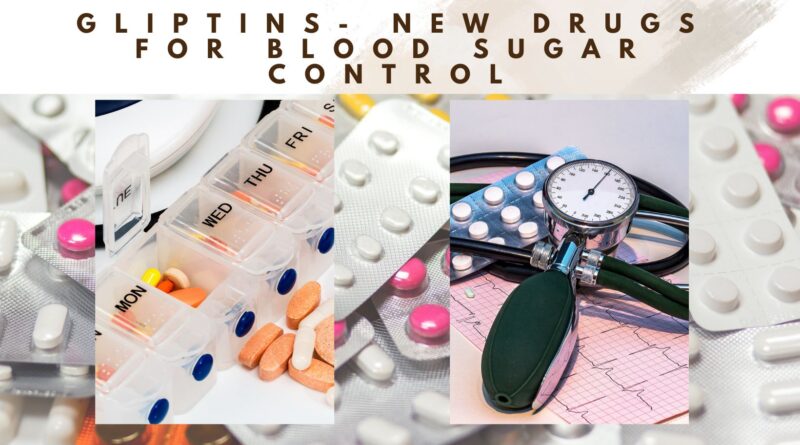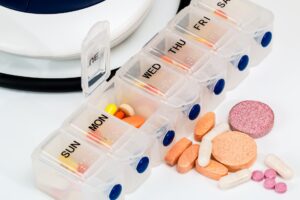Gliptins- New Drugs For Blood Sugar Control
GLIPTINS – What class of drugs and how they work in diabetes
History of Diabetes
Diabetes is a chronic disease that affects how the body processes blood sugar (glucose). The history of diabetes dates back to ancient times, with the first recorded reference to the disease occurring in an Egyptian manuscript from around 1500 BCE. The manuscript describes the symptoms of diabetes, including frequent urination and excessive thirst.
In the following centuries, physicians and scholars observed and studied the disease, often referring to it as “the pissing evil” due to the frequent urination associated with the condition. However, it wasn’t until the 17th century that diabetes was identified as a distinct disease.
In 1776, an English physician named Matthew Dobson identified the presence of sugar in the urine of people with diabetes. This discovery led to the development of the first blood glucose test in the 20th century.
In the 1920s, insulin was discovered by Canadian scientists Frederick Banting and Charles Best, revolutionizing the treatment of diabetes. Before insulin, the only treatment available was a strict diet and exercise regimen, which often proved ineffective in managing the disease.
Today, diabetes is a global health epidemic, with over 460 million people affected worldwide. While much progress has been made in the treatment and management of diabetes, there is still much to be learned about the disease and how best to prevent and treat it.
Drugs Available for Diabetes
There are several classes of drugs available to treat diabetes. Some of the most commonly used drugs are:
Metformin: This is the most commonly prescribed medication for people with type 2 diabetes. It helps to lower blood sugar levels by reducing the amount of glucose produced by the liver and improving the body’s sensitivity to insulin.
Sulfonylureas: These drugs stimulate the pancreas to release more insulin, which helps to lower blood sugar levels. Examples include glyburide, glipizide, and glimepiride.
GLIPTINS -DPP-4 inhibitors: These drugs help to lower blood sugar levels by increasing the amount of insulin released by the pancreas and reducing the amount of glucose produced by the liver. Examples include sitagliptin, saxagliptin, and linagliptin.
GLP-1 receptor agonists: These drugs mimic the action of a hormone called glucagon-like peptide-1 (GLP-1), which stimulates insulin release and reduces the amount of glucose produced by the liver. Examples include exenatide, liraglutide, and dulaglutide.
SGLT2 inhibitors: These drugs work by preventing the kidneys from reabsorbing glucose from the urine, which helps to lower blood sugar levels. Examples include canagliflozin, dapagliflozin, and empagliflozin.
Insulin: This hormone is used to treat both type 1 and type 2 diabetes. It helps to lower blood sugar levels by allowing glucose to be taken up by the body’s cells. There are several types of insulin available, including rapid-acting, long-acting, and combination insulins.
It’s important to note that these medications can have side effects and should only be used under the guidance of a healthcare professional. The choice of medication depends on several factors, including the type of diabetes, the individual’s health status, and other medications being taken.
GLIPTINS – New Drug
Gliptins, also known as dipeptidyl peptidase-4 (DPP-4) inhibitors, are a class of medications used in the treatment of type 2 diabetes. They work by blocking the action of DPP-4, an enzyme that breaks down the hormone incretin. Incretin is responsible for stimulating the release of insulin from the pancreas, reducing the production of glucose by the liver, and slowing down the absorption of glucose from the intestines.
Is it a new drug , actually No. But it became cheap since last 2-3 years and that is why you need to know about this.
The first gliptin drug, sitagliptin (Januvia), was approved by the US Food and Drug Administration (FDA) in 2006. Since then, several other gliptins have been developed, including saxagliptin (Onglyza), linagliptin (Tradjenta), alogliptin (Nesina), and teneligliptin (Tenglyn).
Gliptins are generally well-tolerated and have a low risk of hypoglycemia (low blood sugar). They can be used alone or in combination with other diabetes medications, such as metformin or insulin. However, they may not be as effective as some other classes of diabetes drugs, such as sulfonylureas or GLP-1 receptor agonists, in reducing blood sugar levels.
Some potential side effects of gliptins include headache, nausea, diarrhea, and upper respiratory tract infections. In rare cases, they may also increase the risk of pancreatitis (inflammation of the pancreas) or joint pain. People with a history of pancreatitis or severe joint pain should not take gliptins.
It’s important to note that gliptins are not a cure for diabetes and should be used in combination with a healthy diet and exercise to manage blood sugar levels. If you have diabetes, talk to your doctor about whether gliptins are a suitable treatment option for you.
In this article we will talk about the Gliptins which are available in the market and has became cheap after so many drug patents are finished and why this may the best drug or drug of choice for you. these drugs have amazing effects and now more frequently it is prescribed by the Physicians & Diabetologists.
What are Gliptins?
Gliptins, also known as dipeptidyl peptidase-4 (DPP-4) inhibitors, are a class of oral medications used to treat type 2 diabetes. They work by blocking the action of an enzyme called DPP-4, which breaks down a hormone called glucagon-like peptide-1 (GLP-1). GLP-1 is involved in regulating blood sugar levels by stimulating insulin secretion from the pancreas, reducing the amount of glucose produced by the liver, and slowing down the rate at which food is absorbed from the stomach.
By blocking the action of DPP-4, gliptins increase the levels of GLP-1 in the bloodstream, which leads to improved blood sugar control. Gliptins are typically used as an adjunct to diet and exercise to help manage blood sugar levels in people with type 2 diabetes.

Which gliptin is more effective?
The efficacy of different gliptins depends on the individual and their specific medical condition. In general, clinical studies have shown that all gliptins are effective in lowering blood sugar levels in people with type 2 diabetes.
However, there may be differences in how well individual drugs work for specific people or in certain situations. For example, some studies have suggested that certain gliptins may be more effective in reducing postprandial (after meal) blood sugar levels, while others may be more effective in reducing fasting blood sugar levels.
Additionally, the choice of gliptin may depend on other factors, such as the individual’s medical history, other medications they are taking, and any potential side effects or interactions.
Therefore, it is necessary to consult with a doctor to determine which gliptin may be most appropriate for an individual’s specific needs and medical condition. The healthcare provider can evaluate the individual’s medical history, perform appropriate tests, and make a recommendation based on the individual’s specific situation.
Which gliptin is globally approved?
All four of the currently available gliptins (sitagliptin, saxagliptin, linagliptin, and alogliptin) have been approved for use in various countries around the world, including the United States, Canada, Europe, Japan, and many others.
However, it’s important to note that drug approval processes can vary by country and regulatory agency, and the specific indications and dosages approved for each gliptin may differ. Additionally, the availability of specific gliptins may vary depending on the country and the healthcare system.
Therefore, it’s important to consult with a healthcare provider to determine which gliptin may be appropriate for an individual’s specific needs and medical condition, and to follow the guidance of the regulatory agency in the country where the medication will be used.
How many types of gliptin are there?
There are four types of gliptin or DPP-4 inhibitors currently available for the treatment of type 2 diabetes:
- Sitagliptin (Januvia)
- Saxagliptin (Onglyza)
- Linagliptin (Tradjenta)
- Alogliptin (Nesina)
- Teneligliptin (Available only in India and Japan)
It’s important to note that the specific indications and dosages of these medications may vary depending on the individual’s medical history, other medications being taken, and other factors. Therefore, it’s important to consult with a healthcare provider to determine which gliptin may be appropriate for an individual’s specific needs and medical condition.
What are the safest DPP-4 inhibitors?
All of the available DPP-4 inhibitors or gliptins are generally considered safe and well-tolerated for the treatment of type 2 diabetes when used as directed and under the supervision of a healthcare provider. However, like all medications, they may carry some risks and potential side effects, and the safety profile may vary depending on the individual and their specific medical condition.
Some studies have suggested that certain DPP-4 inhibitors may have a lower risk of certain side effects compared to others. For example, sitagliptin may have a lower risk of hypoglycemia (low blood sugar) compared to some other gliptins, while vildagliptin may have a higher risk of liver-related side effects in some individuals.
Ultimately, the choice of medication will depend on a variety of individual factors, such as medical history, other medications being taken, and potential drug interactions. Therefore, it’s important to consult with a healthcare provider to determine which medication may be appropriate for an individual’s specific needs and medical condition. The healthcare provider can evaluate the individual’s medical history, perform appropriate tests, and make a recommendation based on the individual’s specific situation.
Like all medications, gliptins or DPP-4 inhibitors have potential side effects, although not everyone who takes these medications will experience side effects. Some common side effects of gliptins include:
- Headache
- Nasopharyngitis (inflammation of the nose and throat)
- Upper respiratory tract infection
- Diarrhea
- Nausea
- Hypoglycemia (low blood sugar) when used in combination with insulin or insulin secretagogues (such as sulfonylureas)
- Allergic reactions, such as rash or hives
Less commonly, gliptins have been associated with more serious side effects, such as pancreatitis (inflammation of the pancreas) and joint pain. In rare cases, they may also cause a serious allergic reaction called anaphylaxis, which requires emergency medical attention.
In addition to these side effects, individual DPP-4 inhibitors may carry specific risks or considerations. For example, vildagliptin has been associated with an increased risk of liver enzyme elevations, while saxagliptin has been associated with an increased risk of hospitalization for heart failure in some individuals.
It’s important to discuss any potential side effects or concerns with a healthcare provider before starting any new medication. A healthcare provider can evaluate an individual’s medical history, perform appropriate tests, and provide guidance on the risks and benefits of a particular medication. If an individual experiences any unusual or severe side effects while taking a gliptin, they should contact their healthcare provider immediately.





